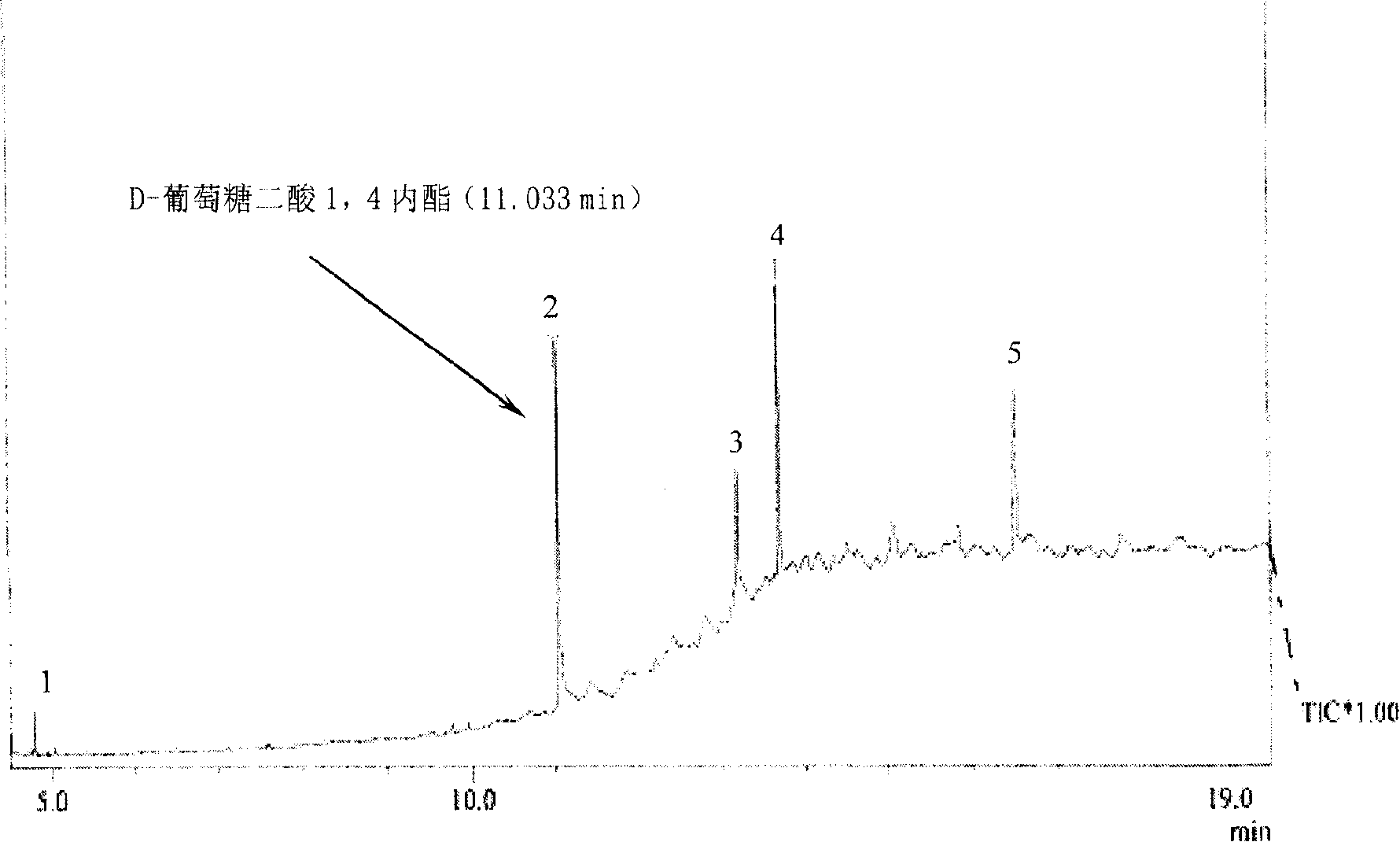Gluconobacter and its use
A technology of gluconoacetic acid bacteria and acetic acid bacteria, applied in gluconoacetic acid bacteria and its application fields, can solve the problems of unclear specific strains of D-glucaric acid 1,4 lactone and lack of large-scale industrial production , to achieve broad industrial applications and market prospects, low cost, and simple fermentation process
- Summary
- Abstract
- Description
- Claims
- Application Information
AI Technical Summary
Problems solved by technology
Method used
Image
Examples
Embodiment 1
[0028] Example 1. Screening of Gluconacetobacter sp. CGMCC № 1157 Acetobacter solid medium: glucose 100g, yeast extract 10g, calcium carbonate 20g, agar 15g, distilled water 1000mL, pH 6.8, extinguished at 121°C bacteria for 15 minutes.
[0029] Sugar tea water culture medium: 5g / 100ml glucose, the final concentration of solids is 0.5 Baumé tea extract, pH 4.9.
[0030] The screening steps of Gluconacetobacter sp. Jlab A4 (Gluconacetobacter sp.) are as follows:
[0031] 1. Preliminary screening
[0032] 1. After oscillating and mixing the activated kombucha mixed strains (sampled in folks in Beijing), take 10mL of bacterial liquid and a small piece of bacterial film into 90mL of sterile water with glass beads, fully oscillate and mix; absorb 5mL to 45mL sterile water, mix well and then dilute to 10 -2 、10 -3 、10 -4 、10 -5 and 10 -6 , draw 10 respectively -4 、10 -5 and 10 -6 Spread 0.1mL of the three dilutions of the bacterial solution on the solid medium of Acetobact...
Embodiment 2
[0053] Embodiment 2, the fermentation production of gluconacetobacter sp. (Gluconacetobacter sp.) Jlab A4 CGMCC № 1157
[0054] Include the following steps:
[0055] 1. Cultivation of Gluconacetobacter sp. Jlab A4 CGMCC № 1157 seed solution
[0056] Acetobacter liquid medium: glucose 100g, yeast extract 10g, calcium carbonate 20g, distilled water 1000ml, pH 6.8, sterilized at 121°C for 15min.
[0057] Use an inoculation loop to pick 1 loop of the strain from the slant and inoculate it in 10 mL of Acetobacter liquid medium, culture it with shaking at 30°C for 24 hours, and then inoculate it in sugar tea water medium at a ratio of 20% (volume ratio) for continuous Two expansion cultures were carried out at 30°C for 24 hours with shaking.
[0058] 2. Fermentation
[0059] Sugar tea water medium: Yunnan Dianhong tea leaf extract with a solid concentration of 0.5 Baume, 5g / 100ml glucose, pH 4.9.
[0060] Inoculate the seed solution of step 1 in the ratio of 10% (volume ratio) t...
Embodiment 3
[0061] Embodiment 3, the fermentation production of gluconacetobacter sp. (Gluconacetobacter sp.) Jlab A4 CGMCC № 1157
[0062] Include the following steps:
[0063] 1. Cultivation of Gluconacetobacter sp. Jlab A4 CGMCC № 1157 seed solution
[0064] With embodiment 2.
[0065] 2. Fermentation
[0066] Inoculate the seed liquid of step 1 in the ratio of 10% (volume ratio) to sugar tea water medium (except pH 4.0, others are the same as in Example 2) (150mL medium in a 250mL Erlenmeyer flask), and culture at 25°C and 160rpm with shaking After 6 days, the content of D-glucaric acid 1,4-lactone in the fermentation broth was determined to be 3.46 mg / mL after the fermentation.
PUM
| Property | Measurement | Unit |
|---|---|---|
| concentration | aaaaa | aaaaa |
Abstract
Description
Claims
Application Information
 Login to View More
Login to View More - R&D Engineer
- R&D Manager
- IP Professional
- Industry Leading Data Capabilities
- Powerful AI technology
- Patent DNA Extraction
Browse by: Latest US Patents, China's latest patents, Technical Efficacy Thesaurus, Application Domain, Technology Topic, Popular Technical Reports.
© 2024 PatSnap. All rights reserved.Legal|Privacy policy|Modern Slavery Act Transparency Statement|Sitemap|About US| Contact US: help@patsnap.com










